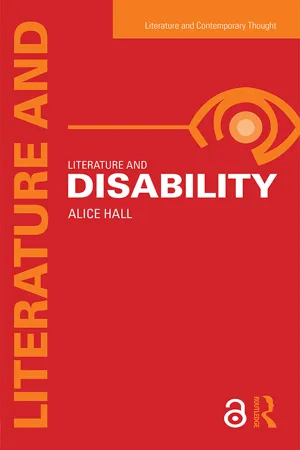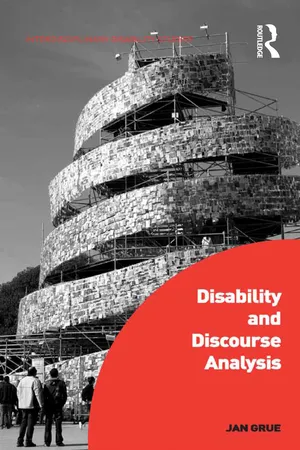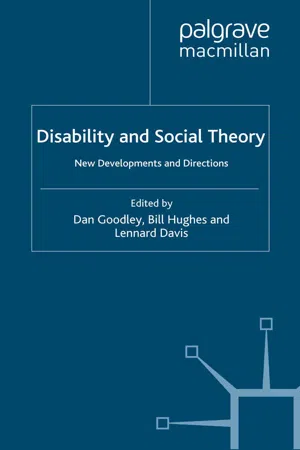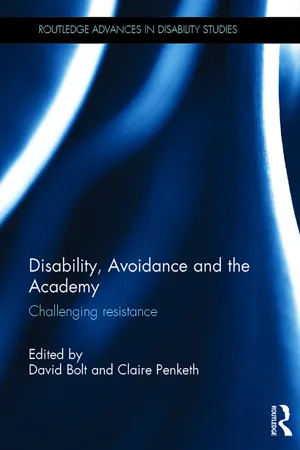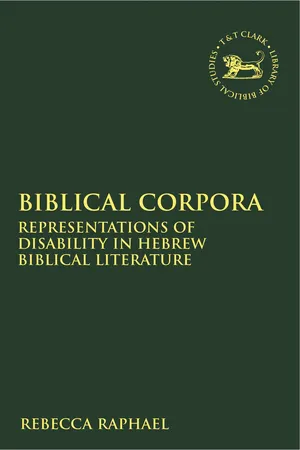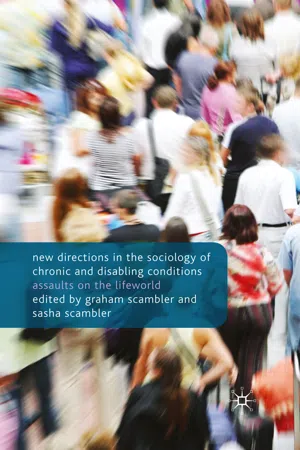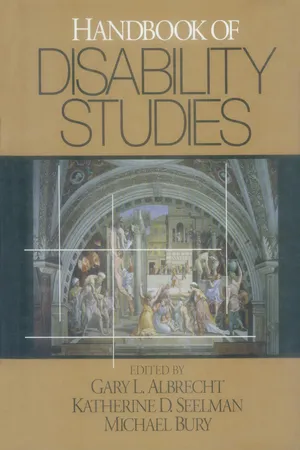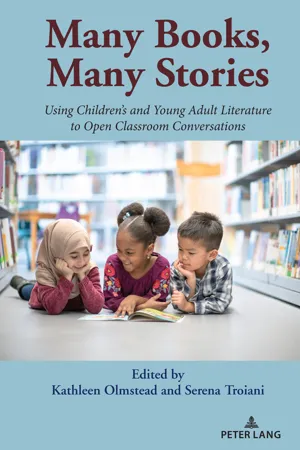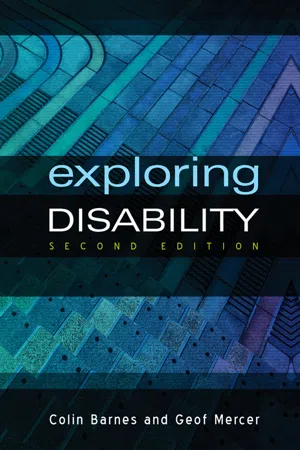Literature
Disability Theory
Disability theory examines the social, cultural, and political aspects of disability, challenging traditional views and promoting the rights and inclusion of people with disabilities. It critiques the medical model of disability and emphasizes the importance of understanding disability as a social construct shaped by power dynamics and societal attitudes. Disability theory seeks to dismantle barriers and promote equality and accessibility for all individuals.
Written by Perlego with AI-assistance
Related key terms
1 of 5
10 Key excerpts on "Disability Theory"
- eBook - ePub
- Alice Hall(Author)
- 2015(Publication Date)
- Routledge(Publisher)
Disability Theory 2). Yet, the analysis of literary and cultural texts has contributed significantly to the understanding of politics, aesthetics, ethics and social attitudes towards disability that has emerged. Theoretical work can offer perspectives that actively challenge and reformulate understandings of some of the key questions of our age about global citizenship, knowledge production, discrimination, notions of the normal, genetic testing and social care.Theorists writing in the literary domain share a marked sense of the critical potential of the field. For Davis, disability perspectives have the power to invigorate the whole field of literary theory and criticism:The study of literature, literary history, and theory have only begun to fall under the sway of disability studies. The grotesque, the gaze, the dialogic, visual theory, the law, and so on – all are beginning to be broached by interrogations of disability. The exciting thing is the emergence of a whole new field in literary studies at the moment when many felt there was nothing new under the hermeneutic sun. The survival of literary studies may well belong not to the fittest, but to the lame, halt, and the blind, who themselves may turn out to be the fittest of all.(“Crips Strike Back: The Rise of Disability Studies” 510)Theories of gender, sexuality, race and postcoloniality all call into question naturalised identities and expose the fluid and culturally constructed nature of the boundaries of the normal. Sometimes seen from the outside as a peripheral – as yet another sub-genre in a growing list of identity studies – Disability Theory in fact has the potential, as Siebers suggests, “to transform critical and cultural theory all over again” (Disability Theory 3). Whereas Garland-Thomson positions herself as a critic at the margins, moving towards the centre: “I probe the peripheral so as to view the whole in a fresh way” (Extraordinary Bodies: Figuring Physical Disability in American Culture and Literature - eBook - ePub
- Jan Grue(Author)
- 2016(Publication Date)
- Routledge(Publisher)
This should not be a very controversial assumption (although you never know), but it is too inclusive for many practical purposes. It is possible to articulate a theory of disability which restricts itself only to individual bodies and their physiology, although such a theory would be alien to almost everyone who has any experience with disability and disabled people. My second assumption is that Disability Theory, as relevant to Disability Studies, hypothesizes about what disability is and how it is produced, in social, cultural, and historical context. The list of adjectives at the end of the last sentence could be extended for quite a while – certainly by including politics and economics – so I am defining “context” in an open-ended way here. With these assumptions in mind, I am going to adopt an inclusive stance towards the current landscape of Disability Theory. This is, I think, a necessary strategy. The 2013 edition of Lennard Davis’ The Disability Studies Reader includes sections with the following titles: historical perspectives, the politics of disability, stigma and illness, theorizing disability, identities and intersectionalities, disability and culture, and fiction, memoir, and poetry. Although theory ostensibly has its own section, many if not most of the book’s chapters draw on and contribute to the theorization of disability. There is no single theory of disability, nor is there likely to be one. This need not be a cause for concern. As is often pointed out (in academic discourse), the word “theory” is etymologically rooted in the Ancient Greek word for “seeing”, for making something visible. A theory of disability is valuable insofar as it makes disability better understood, more clearly seen. This criterion can be met in pluralist fashion - eBook - PDF
Disability and Social Theory
New Developments and Directions
- D. Goodley, B. Hughes, L. Davis, D. Goodley, B. Hughes, L. Davis(Authors)
- 2012(Publication Date)
- Palgrave Macmillan(Publisher)
1 1 Introducing Disability and Social Theory Dan Goodley, Bill Hughes and Lennard Davis Introduction Theorising disability lies at the heart of many recent social scientific engage- ments with the body, subjectivity, culture and society. Disability studies have developed across, through and with disciplines of the social sciences and humanities. The extent to which disability illuminates and puts into practice social theory and, moreover, the potential of social theory to add to our understandings of disability are key themes of this book. This text aims to further examine social theory and disability as resources for thought, action and activism. Social theories of disability have been around for decades, with more criti- cal approaches emerging around 40 years ago. The awareness of Disability Theory continues to lag behind that of other transformative arenas such as feminism, queer theory and postcolonialism. To some degree, Disability Theory has not had the sweep and global interest of these other areas due to the stigma that disability still carries, despite years of legislation and strug- gle. It still is not fashionable to be disabled. As a consequence, disability politics have been virtually ignored not only by dominant institutions of society but also by other politicised arenas. The disabled people’s move- ment, while now global in scale and reach, continues to push for some of the most basic rights to education, life and health. At the time of writing, The United Nations’s Convention on the Rights of Persons with Disabilities is still being ratified (or not) by some nations of the world. Disability studies con- tinue to be slighted in many university courses and Disability Theory is often absent from readers on social theory. Our aim, as editors of this book, was to invite contributors from a broad range of social sciences and ask them to inject their chosen theoretical perspectives into disability studies. - eBook - ePub
Disability, Avoidance and the Academy
Challenging Resistance
- David Bolt, Claire Penketh, David Bolt, Claire Penketh(Authors)
- 2017(Publication Date)
- Routledge(Publisher)
10 Literary disability studies in creative writing A practical approach to theory Cath Nichols DOI: 10.4324/9781315717807-11 How might we bring disability literary studies to the practice-based discipline of creative writing, a discipline that largely avoids theoretical discussion as well as any discussion of disability in literature? In this chapter I propose teaching the writing of fiction, script, and poetry in ways that might combat the current avoidance of disability topics and/or approaches on creative writing programmes. Creative writing tutors may not have had a previous university education and often learn their pedagogical approach and any attached theories in post. They teach the fields in which they have been published: usually Short Story, the Novel, Script, Poetry, or Life-writing. A few universities offer genre modules too, such as Sci-fi, Horror or Children’s Fiction. It is all too easy to teach creative writing by always referring to white, middle-class, non-disabled male writers and using their literature in course materials. In some places reading lists are more varied: gender and race may be addressed, but disability studies, queer theory, and class theory are generally avoided. I propose three pro-active ways in which creative writing tutors might act with regard to literary disability studies. First, as a form of trouble-shooting, tutors might challenge negative stereotypes and inappropriate language as it arises (e.g., mis-use of schizophrenic to mean two-sided). Second, there is implicit engagement, whereby tutors use materials that contain disabled characters to illustrate key craft topics (e.g., how to write good dialogue) - eBook - PDF
Biblical Corpora
Representations of Disability in Hebrew Biblical Literature
- Rebecca Raphael(Author)
- 2009(Publication Date)
- T&T Clark(Publisher)
To return to the distinction between impairment and disability, one might ask what exactly makes this bodily difference have all the social implications that it does. 18. Rebecca Raphael, “Images of Disability in Hebrew Prophetic Literature” (paper presented to the Central Texas Biblical Studies Seminar, Austin, October 24, 2003). 19. David T. Mitchell and Sharon L. Snyder, Narrative Prosthesis: Disability and the Dependencies of Discourse (Ann Arbor: The University of Michigan Press, 2000), 3. 20. Ibid. 21. Ibid. 1. Introduction 11 1 In short, while acknowledging the existence of real physical differ-ences, Davis, Garland Thomson, and Mitchell and Snyder all treat disability as part of larger representational systems and ideological structures. One cannot begin to define disability without reference to something else, and that something else also requires definition. Schipper summarizes this model and its implications thus: …according to the cultural model, disability is not only a result of social organization, but integral to social organization itself. Thus, the goal of disability studies becomes not jus the isolation and removal of social barriers that disabled people with impairments, but the interrogation of how society uses the category “disability” to narrate, interpret, and organ-ize its world. In this sense, representations of disability are not value-free or transparent, but help to develop and work out social and cultural ideologies or worldviews. 22 To transpose this description into historical terms, disability studies seeks to elucidate the role of disability within the overall thought struc-ture and value system of a given set of texts or artifacts, from a given time and place. Mitchell and Snyder provide a useful typology of disability studies. 23 In surveying the field in 2000, they list five major approaches. First, studies can focus on a survey and critique of negative imagery, such as Shakespeare’s depiction of Richard III. - eBook - PDF
New Directions in the Sociology of Chronic and Disabling Conditions
Assaults on the Lifeworld
- G. Scambler(Author)
- 2016(Publication Date)
- Palgrave Macmillan(Publisher)
It followed that the intersection of forms of oppression, and the implications for identity politics, required theorization (Price and Shildrick, 1998, 2002; Shildrick and Price, 1996; Shakespeare, 2006; Thomas, 2007). Feminist writers of all theoretical persuasions have led this work, and in so doing have brought to light new dimensions of disablism. For example, the old insistence on the importance of per- sonal experience, and on the need to transcend the personal/private divide, set the stage for research on so-called private matters: on psycho- emotional disablism, and on living with impairment and impairment effects (Reeve, 2007; Thomas, 1999, 2007). Sociologies of disability and chronic illness The intellectual relationship between representatives of British medi- cal sociology and disability studies in the 1980s and 1990s was tense and distant, with occasional episodes of outright clash and contesta- tion. Five of these episodes are discussed in some detail in Sociologies of Disability and Illness Contested Ideas in Disability Studies and Medical Sociology (Thomas, 2007). The headlines from the disability studies’ point of view were: (a) medical sociologists use definitions of disability that are essentially medico- centric, including the one found in the ICIDH 7 , and thus understand impairment to be the cause of disability (b) in their interpretative research with chronically ill and disabled people, medical sociologists concentrate on individual suffering and personal psychosocial adaptation to the socially deviant status that living with impairment denotes (c) medical sociologists rarely name or analyse the socio-structural or interpersonal manifestations and consequences of disablism, and (d) the agency of disabled people has been ignored or narrowly channelled towards notions of adjustment to their fate. - eBook - PDF
- Gary L. Albrecht, Katherine D. Seelman, Michael Bury, Gary L. Albrecht, Katherine Delores Seelman, Michael Bury(Authors)
- 2001(Publication Date)
- SAGE Publications, Inc(Publisher)
Some of this work is explored in other chapters. The point for our purposes is to recognize that theorizing disability is not merely about abstractly conceptualizing the relationships between impairment and situations—it is about how those relationships work for people in dynamic and complex personal and social processes. It is a body of work that has many origins. It partly origi-nates in a growing interest in narratives or other first-person accounts, across a range of disci-plines and beyond the specific issues of illness and disability (see Hinchman and Hinchman 1 9 9 7 for examples). It is also a form of discourse about illness that has been given a high public profile by the history of HIV/AIDS, in which the intersections of personal identity and the his-tory of a societal response to disease, disability, and death have, of course, been particularly sharply defined (Couser 1 9 9 7 ) . While some o f this work emphasizes the materiality and the his-toricity of such narratives—the political economy of illness (Radley 1993)—other research en-gages more and more deeply with the subjectivity of the experience—the negotiation and renegotiation of identity through talk, the rediscovery of self in the chaos of illness, and so on (Sacks 1 9 8 5 ) . Some have explored with great skill and empathy the different kinds of narratives that can be constructed about the experience of chronic—often terminal—illnesses (Frank 1 9 9 5 ; Mathieson and Stam 1 9 9 5 ) . In much of this narrative-based work, what started as a sociological analysis becomes part of a quasi-religious or spiritual quest for the truth, which illness is supposed to reveal. So profound is the truth of illness that even the person experiencing the illness is merely a vehicle for allow-ing the body to speak of its suffering. This is truly the body incarnate: The body is not mute, but it is inarticulate; it does not use speech yet begets it. - eBook - PDF
- Katie Ellis, Gerard Goggin(Authors)
- 2017(Publication Date)
- Red Globe Press(Publisher)
Staring, which can be considered an intense form of looking, marks disability as aberrant and contributes to the positioning of power relations between those considered (non-) disabled. As Mitchell and Snyder argue, while disability dominates cultural nar-ratives, we lack a coherent critical framework with which to understand them. Mitchell and Snyder provided one of the first comprehensive accounts of disability and culture through their discussion of ‘narrative prosthesis’ – or the way, as we shall see in the discussion regarding tele-vision in Chapter 5 , that narrative functions rather like the old idea of an artificial limb, as a supplement, or to prop things up (Mitchell and Snyder, 2000). Their subsequent work focused on understanding how disability is located in culture, what its characteristics are, and what role it plays (Snyder and Mitchell, 2006). A wide range of research has tack-led disability in literature, art, and aesthetics (Siebers, 2010), as well as Understanding Disability and Media 33 in other cultural forms such as music (Lubet, 2011; Straus, 2011), and toys (Ellis, 2010a, 2012a). There has also emerged a new body of Disability Theory to which cultural theory is central, such as Fiona Kumari Campbell’s Contours of Ableism (Campbell, 2009), which draws on critical race and post-colonialism studies; Robert McRuer’s Crip Theory , engaging with queer theory (McRuer, 2006); Tobin Sieber’s Disability Theory (Siebers, 2008), taking on long-standing issues of identity and rights; Dan Goodley’s argument for the importance of understanding self, relationships, and ideology in the making of culture and disability, via psychoanalysis (Goodley, 2011: 123ff.); and a relatively slim if growing body of work on disability from a cultural studies’ perspective (see, for instance, Diedrich, 2005; see also, since 2009, the Journal of Literary and Cultural Disability Studies ). - eBook - PDF
Many Books, Many Stories
Using Children's and Young Adult Literature to Open Classroom Conversations
- Kathleen Olmstead, Serena Troiani, Kathleen Olmstead, Serena Troiani(Authors)
- 2023(Publication Date)
4. Disability and Ableism in Literature JENNIFER A SHTON, GRACE K ELLY & A MANDA FLUGEL We presume that students do not notice differences and that differences do not matter. However, the opposite is true. Humans notice differences, it is the meaning that we attribute to these differences that has the potential to do great harm or provide important validation. However, we can also inflict damage by erasing or invalidating people’s lived experiences. As Matthew and Clow (2007) observed, “what could possibly be worse for a child than not being included, being ignored, having your very existence denied?” (p. 72). This chapter discusses the roots of ableism in young adult and children’s literature and proposes that thoughtfully chosen titles can spark conversa- tions that challenge students to rethink their understandings of disability and disabled people. This chapter also includes a rubric, created by the authors, which teachers can use to evaluate literature for inclusion in their classroom libraries. Through intentional efforts to discuss ableism educators can pre- pare their students to better understand themselves and others while also helping to disrupt dominant ideologies that marginalize people. As a source of rich narratives and counter-narratives, literature has the potential to reproduce or disrupt problematic preconceptions about various groups of people from all aspects of society. The way characters are por- trayed can have a very powerful influence on readers and affect the way they perceive themselves and their relationships with others- particularly those whose identities differ from their own. This means, however, that we must rely on authors to depict characters in ways that are not only accurate, but more importantly unbiased. Problematic representations of identities per- petuate stereotypes, prejudice, and bias and reproduce inequity in society. - eBook - ePub
- Colin Barnes, Geof Mercer, Colin Barnes, Geof Mercer(Authors)
- 2018(Publication Date)
- Polity(Publisher)
Moreover, studies of the lived experience of impairment and the psycho-emotional consequences of coming to terms with both impairment and disability are a growing feature of disability studies analyses of the process of disablement. This has added weight to those who would argue for a more inclusive, ‘relational’ or ‘all-round’ approach to the study of the ‘lived experience’ of disablement and a reappraisal of the meaning of disability which would have the added advantage of connecting with those people with impairments or chronic illnesses, ‘old and young’, who do not identify as ‘disabled’ and ‘refuse to recognize disabled signifiers in their own lives’ (Thomas, 2007, p. 177). Inevitably, however, such arguments underpin the views of those who promote an ‘embodied rationale’ in support of the traditional medical sociological view that disability is a restricted activity caused mainly by impairment or ‘chronic illness’ (Williams, 1999; Bury, 2001), as discussed in chapter 3. In so doing, they fuel support for a more ‘enlightened guardianship’ approach to disability politics and policy which effectively allows politicians, policy-makers and bureaucrats to vacillate between medical and political solutions to the process of disablement (Dartington et al., 1981), illustrated by Harlan Hahn’s (2002) discussion of judicial responses to disability discrimination cases in American law courts referred to in chapter 2. Review This chapter has focused on the emergence of Disability Theory. The generation of social political understandings of disability, in particular, the concept of independent living and the social model of disability, has generated new ways of conceptualizing the complex process of disablement. Indeed, their impact in focusing attention on social barriers within both the disabled and the academic communities is not in doubt and forms the entry point into chapter 5. But different theoretical and political emphases have emerged
Index pages curate the most relevant extracts from our library of academic textbooks. They’ve been created using an in-house natural language model (NLM), each adding context and meaning to key research topics.
